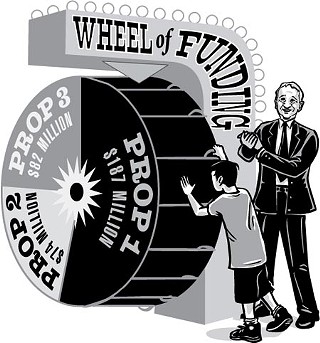Pat Forgione's Last Sales Job
AISD Bond Election
By Richard Whittaker, Fri., April 11, 2008
With more than $343 million in bonds for the Austin Independent School District on the May 10 election, voters face many projects that are either mandated or driven by long-established policy. Of the three propositions on the ballot, only Proposition 3 is neither a response to state or federal regulations nor district overcrowding standards. But its projects reflect the external pressures AISD staff faces over investment: The proposed districtwide performing-arts center comes after years of lobbying from parents, while the planned land purchase for a future South Austin high school may redress perceived shortcomings in long-term planning. But while these are elective, other proposals, like bathroom repairs and technology investment, are required to keep the district safe and legal. So the first question has to be: Are bonds the best way to pay for them?
Superintendent Pat Forgione thinks so. Projects paid for by bonds are part of the interest and sinking budget, or I&S, a repayment method designed for managing debt. If the bond is not approved and the district pays for the projects anyway, then costs come out of the regular maintenance and operation budget. "Maintenance and operation is a bean-counter way of saying salaries, utilities, maintenance, building upkeep – the expenses that are necessary to keep your schools open and running," AISD spokesman Andy Welch explained. "Interest and sinking is a fancy way of saying what it costs to get your school open, the capital-intensive building costs."
"With M&O, we have a surcharge of 30 percent because of school finance recapture," said Forgione, who will retire next year. Under Chapter 41 of the Texas Education Code, school districts are classified as property-wealthy or property-poor: Since AISD is classified as property-wealthy, it remits $100 million a year to the Texas Education Agency to subsidize property-poor ISDs. But that property metric, Forgione argues, is inaccurate. "No one ever thought a big district, and one with poor kids, would be in recapture. But I have 50,000 kids out of my 83,000 living at or under the poverty line," he said. "There's a financial advantage for the Austin taxpayer of putting it on I&S, because we get to keep every dollar" of the money raised from bonds.
While some investments proposed in the bond are sensible or desirable, others are mandatory. More than $17 million of the $73 million in Proposition 2, for example, must be spent, or the district risks breaking city, state, or federal regulations. Nearly $2 million would fund kitchen renovations to meet health codes, and there are essential campus repairs needed for Americans With Disabilities Act compliance. Another $14.5 million will go on energy-regulating capacitor banks. New standards laid down by the North American Electric Reliability Corp. (NERC, which runs the national bulk power system) require big consumers to run their electrical systems at 97% efficiency. "These are absolute requirements that before were best practices," explained Austin Energy spokesman Ed Clark, "and this equipment will allow them to reach that standard." Not buying capacitors means $2 million a year in surcharges: avoiding that fee, while saving energy, means the system would pay itself off in seven years.
Another $12 million goes on low-emission school buses. Although not a district mandate per se, Paul Turner, AISD facilities executive director, calls it being a good neighbor on nitrogen-oxide attainment levels. "The area is trying to meet [Environmental Protection Agency] standards, and this is a way for the district to get involved," he said. There are also some common-sense investments. "You can still do grades with paper and pencil, if you want," said Turner, but the district would rather invest $1.5 million in an integrated student-records system to replace the current software that IT firm Pearson School Systems will no longer support after 2012.
Not every investment means savings. Others come from unfunded state mandates, like $36 million for science labs to meet new high school graduation requirements. "The Lege says, 'We love it; raise the standards,'" explained Forgione, who supports the change but would have appreciated some state cash. "We have to build two to four science labs in each school, because they're out of date." This doesn't just mean new, state-of-the-art facilities: Higher chemical disposal standards mean older labs may need retrofitting.
Then there's $70 million for technology. New online testing requirements take effect in 2010, and though not technically mandatory for two more years, AISD staff is concerned about sufficient planning. "In a large district like this, you have to have all your ducks in a row, or you'll have trouble," said Turner. AISD is also having to ramp up its five-year equipment-refreshment plan to meet the 1-1 student-computer ratio in TEA's 2020 plan. "The state hasn't addressed how people should approach 1-to-1; it's just going to happen," said Gray Salada, executive director of information services and technology. Rather than buying a machine per child, the district proposes mobile laptop carts. "This 'virtual' one-to-one would probably work as a relatively inexpensive way to adjust," said Salada. Forgione again sees this as an unfunded state mandate. "They give us $35 a child for technology, and we figure we need $500," he said. And since the bond only covers physical investment, the district will also have to find more space in the regular budget to support and expand on the 12 technicians that keep its 35,000 computers running.
But even unfunded mandates only set minimums. Part of the district's job is planning for overcrowding. Most Austin schools face this issue, and the district tries to keep them below 125% capacity. But, said Turner, that's "a rule of thumb." Of four elementaries with construction planned with Proposition 1 bond money, only two – Barrington (132%) and Linder (155%) – break that level, and boundary changes drop Linder to 120%. Hart (124%) is on the margin, and Langford (119%), with 36 portables, "has more classrooms outside than it does in the building," said Turner. Even with boundary adjustments, Turner argues, without adding classrooms, those percentages "will start to creep back up."
Prop. 1: $187,797,315
Tax rate impact: 0.9 cents per $100 valuation
Relief for overcrowding and support for academic achievement
Linder Elementary Early Childhood Center $24,000,000
Barrington Elementary eight-classroom addition $4,313,318
Hart Elementary eight-classroom addition $4,442,242
Langford Elementary eight-classroom addition $4,367,607
Undesignated elementary school $25,168,951
Land acquisition for undesignated elementary $2,574,880
Auditoriums at Lanier and McCallum high schools $16,742,000
High school science labs $36,338,317
Technology upgrades $69,850,000
Prop. 2: $73,920,504
Tax rate impact: 0.4 cents per $100 valuation
Health, safety, environment, critical renovations, and other needs
Campus cafeteria kitchen renovations $1,852,787
Menchaca Elementary internal roadway $826,836
Purchase of low-emission school buses $12,205,600
Capacitor banks for energy savings $14,569,913
Critical renovations at various campuses $37,213,068
Upgrade of payroll software $1,045,000
Replacement of cold-storage warehouse $6,207,300
Prop. 3: $82,000,000
Tax rate impact: 0.4 cents per $100 valuation
Special programs and expansion
Districtwide performing-arts facility $40,000,000
Land acquisition for South Austin high school $32,000,000
Classrooms and renovations at Anderson High $10,000,000
Total: $343,717,819
Tax rate impact: 1.7 cents per $100 valuation
Got something to say on the subject? Send a letter to the editor.











